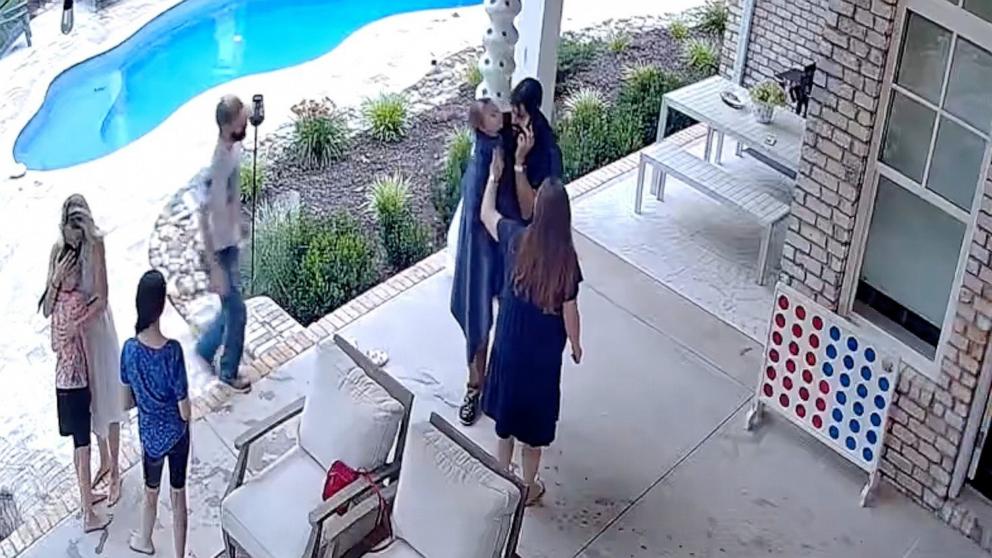


A couple from North Carolina recently experienced a terrifying incident after their 2-year-old daughter nearly drowned in the pool at the back of their house.
In a surveillance video released Tuesday by Gastonia Police Department on X, formally known as Twitter, Mila can be seen lifeless lying by the side of the pool while her dad and their family friend frantically tried to save her by performing CPR on the toddler over the Memorial weekend.
Speaking to ABC News in an interview on Thursday, Matthew Shortridge said he was watching the kids in the pool with other adults nearby and looked away for a moment when suddenly he heard the "blood-curdling screams" from his other daughter.
"My daughter [Mila] got up and went on the porch to my wife, and my wife took her arm floaties off, but my wife had to go to the restroom and one of our friends took her life vest off. I had turned my head, just for a little while ... and Mila walk[ed] back down into the pool without her floaty or life vest on. And that's when my [other] daughter saw her floating with her head in the water… And my daughter screams out, 'Mila,' you know, really loud."
When Mila was removed from the pool, Shortridge said Mila looked "blue gray," she was "not breathing," she was "limp," and "lifeless."
Shortridge said he and their family friend, who is a nurse, immediately jumped into action to revive the toddler while another relative made an emergency call to 911.
July has the highest number of drowning deaths. Here's how to prevent themAfter two and half minutes of performing the CPR, Shortridge said Mila finally let out some air and started breathing.
"And so then at that moment, I started to feel a lot more hopeful, but I was still worried about her neurological condition," Mila's mom, Amy Shortridge, told ABC News. "So when my husband, we were kind of all walking around the pool trying to assess how she was at that point, I kept asking him, how's she doing? How's she doing? And that's when we had both heard her say, 'Daddy.' And at that moment when she recognized him, I knew that she was healed and she was well."
Mila was eventually transported to a hospital when paramedics arrived at the house and she has since recovered, her family said.
After encountering the near tragic moment, Matthew and Amy are sharing their story to highlight the importance of having life-saving knowledge in the case of emergencies.
"The most important thing is to make sure you know what to do in a situation, to fix the situation," Matthew explained. "And, you're okay and to make sure you know what to do to save a life, to have those skills. If you have a pool, even if you don't and you're a parent, it's important to take those CPR classes so that you know what to do in case of an emergency."
"And it's also important to stay calm and clear and not to panic," he added.
Drowning is the leading cause of death among children ages 1 to 4 in the United States, according to the U.S. Consumer Product Safety Commission, which released data this month showing that drownings are on the rise among kids under the age of 15.
Therefore, it is critical to have multiple layers of protection for children around water to ensure their safety.
Dr. Sarah Denny, a professor of pediatrics at The Ohio State University and lead author of the American Academy of Pediatrics' "Prevention of Drowning Technical Report," shared her seven tips with ABC News. Scroll down to learn more.
1. Model safe behavior. Parents should wear personal flotation devices alongside kids. "When we're thinking about any sort of injury prevention mechanism -- like wearing a seatbelt, wearing a bike helmet, wearing a life jacket -- we know that kids are much more likely to use those things if they are seeing their parents use them as well," Denny said.
2. Avoid using water toys as safety equipment. Toys like water wings, inflatables and noodles are meant for recreation, and "have no safety components or traits about them," according to Denny.
3. Stay vigilant and nearby kids in or around water. Wearing a life jacket or having a lifeguard on duty does not replace the need for "constant, capable supervision," according to Denny, who recommends adults stay within arm's reach whenever children are in and around water.
4. Make sure your pool is fenced in. A fence around a pool is the most effective, proven way to prevent drowning of young children, according to the AAP. The fence needs to be at least four-feet high, non-climbable, have a self-closing and self-latching gate, and surround the entire pool, separating it from the house.
5. Enroll your child and yourself in swim lessons. Swimming is "an important life skill," said Denny, adding that everyone needs to know what to do if they ever fall into water over their head.
6. Learn CPR. In the event of a drowning, the American Heart Association emphasizes the need for "immediate, high-quality bystander CPR," which improves survival. Denny said that fast and effective CPR also has a, "strong impact on long-term outcomes after a drowning incident."
7. Encourage kids to wear bright colors around water. Wearing a bright color -- like orange, red, pink, or yellow -- for both swimwear and life jackets could improve a child's visibility in the water. According to Denny, while not rigorously studied, this simple strategy may help rescuers more easily identify someone in the water.
Michelle March, MD, MPH, MEd is a general pediatrics research fellow at Cincinnati Children's Hospital Medical Center and a member of the ABC News Medical Unit. She contributed to this report.